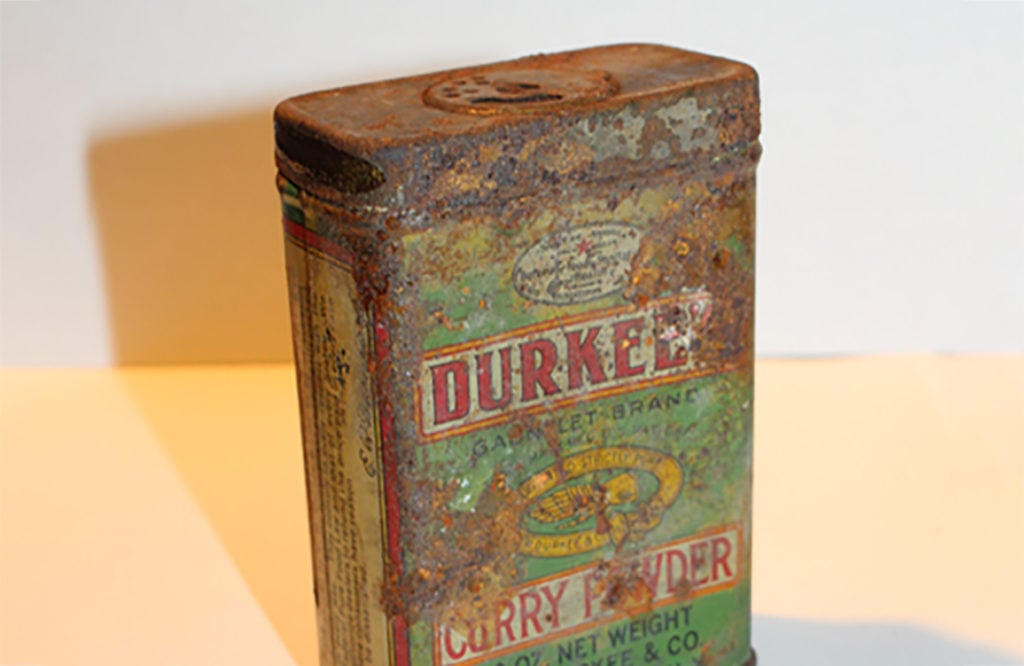This early 20th century can of Durkee Curry Powder, discovered during 2008 restoration and conservation work to create the Tenement Museum’s “Irish Outsiders” tour, immediately intrigued Museum researchers. The preliminary assumption was that curry powder was primarily a North African, South Asian, or Asian spice. Why was it found in an apartment at 97 Orchard Street, which during this period was home to immigrants primarily from Eastern and Southern Europe?
Through subsequent research, we learned that curry powder has a long history in the United States, with popularity dating as far back as the mid-19th century. As early as 1876, recipes featuring curry started to appear in the New York Times, indicating at least some common knowledge of the dishes as well as the general availability of curry powder.
One of the first instances was a recipe from February 13, 1876, for “Curried Fowl a l’Indienne”.[1] On March 12, 1876, an editorial was published by “W.W.M.”, a person who claimed to have studied Indian cooking under Indian cooks, attacking the dishes many American cooks passed off as curries. This writer included their own personal recipe for a “true” East India Curry.[2] Many more recipes followed in subsequent years, including one for making your own curry powder. Ads for the sale of curry powder dated as far back as 1898[3]. By 1903, curry powder was sold in regular grocery stores[4], not just specialty shops, and showed up on the shelves at Macy’s by May of 1909[5].
The popularity of curries didn’t go out of style after this early popularity. Curry powder seems to have been ubiquitous in the 1930’s and 1940’s. An article titled “A Vogue for Curries” ran in the New York Times on October 1, 1939, highlighting the popularity of the spice in American cooking:
“Recently the use of curry has amounted almost to a vogue among Americans and at this season of cooler weather nearly every restaurant menu contains one or two curried dishes. Into the most American of recipes curry powder has been blended, adapted to purely Western foods such as sandwiches, salad dressings and scrambled eggs.”[6]
The Durkee Curry Powder can discovered in 97 Orchard Street dates to between 1918 and 1935. We know this because in 1918, Durkee became the first company to introduce spices sold in cans instead of paper cartons. And by 1935, all of 97 Orchard Street’s residents were evicted from the building due to the then-landlord’s refusal to comply with the 1929 Multiple Dwellings Act, which mandated a series of alterations to its main staircase and adjacent hallways to make them more fireproof.
What does this all mean? The discovery of the brand-name curry powder suggests some of the recently arrived immigrants engaged with American mass consumer food culture during the early 20th century. Despite limited discretionary income, the purchase of seemingly “exotic” spices was not beyond the reach of the immigrants who lived at 97 Orchard Street. The residents were aware of, and participated in, trends in American culinary culture, adapting to their new home by both maintaining their own traditions and incorporating new ones. The presence of a mass-produced, nationally distributed, brand-name curry powder also suggests that early 20th century immigrant residents of 97 Orchard Street were finding a sort of common ground with neighbors of differing ethnic and cultural origins by participating in American food trends that crossed boundaries of class and culture.
[1] “Curried Fowl a l’Indienne”, New York Times February 2, 1876; ProQuest Historical Newspapers online.
[2] “East India Curry”, New York Times February 2, 1876; ProQuest Historical Newspapers online.
[3] Ad for A.A. Vantine & Co., New York Times October 16, 189;: ProQuest Historical Newspapers online.
[4] Ad for James Butler Choice Groceries, New York Times March 12, 1903; ProQuest Newspapers online.
[5] Ad for Macy’s, New York Times May 16, 1909; ProQuest Newspapers online.
[6] Betty Wason, “A Vogue for Curries,” New York Times October 1, 1939; ProQuest Historical Newspapers online.
